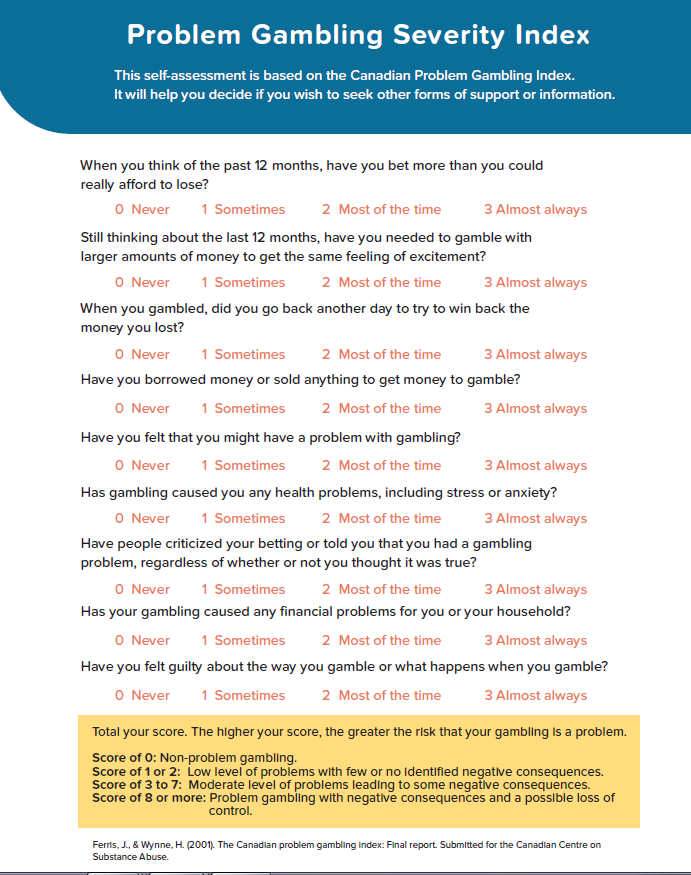
The higher your score, the greater the risk that your gambling is a problem. Score of 0 = Non-problem gambling. Score of 1 or 2 = Low level of problems with few or no identified negative consequences. Score of 3 to 7 = Moderate level of problems leading to some negative consequences. This self-assessment is based on the Canadian Problem Gambling Index. The higher your score, the greater the risk that your gambling is a problem. When you think of the past 12 months, how often. Most states and territories in Australia have adopted the Problem Gambling Severity Index (PGSI) of the Canadian Problem Gambling Index as the standard measure of problem gambling in their prevalence studies and research programs. However, notwithstanding this attempted standardisation, differences in sampling and recruitment methodologies and in some cases the modification of the scoring. The development of the Canadian Problem Gambling Index (CPGI) was the result. Of a collaborative. Problem gamblers (PGSI score ≧ 8) were 7.2% among males and 1.2% among females.

The Canadian Problem Gambling Index (CPGI) is a 31-item measure used for screening purposes to determine whether a person in the general population may have a gambling problem. The CPGI asks questions about an individual's gambling habits from four categories:
- An individual's involvement in gambling;
- Problem gambling behaviour;
- The consequences they (or others) experience as a result of his/her problem gambling; and
- Correlates of problem gambling.
The goal of the CPGI was to create a more meaningful measure of problem gambling to use in general population surveys that includes indicators of the social and environmental context. Indeed, the CPGI was tested and validated in a general population and was able to accurately measure who was a problem gambler and who was not.
River Spirit Casino in Tulsa - one the largest Gaming floors in Oklahoma. Promotions, Player's Club, Dining and Nightlife, live music and performances. Margaritaville Casino 11 Casinos. 8330 Riverside Pkwy. 'This is a beautiful casino. Not at all what I. Newest casino in tulsa oklahoma.

Canadian Problem Gambling Index Scoring Interpretation
Key Points
The CPGI is used in Canada, Australia, United Kingdom, Norway, Iceland, and Tasmania. Like any instrument, the CPGI is based on a specific definition of harmful gambling. Today many researchers have different opinions on the definition of harmful gambling. In order to fit these new definitions researchers modify, add, or remove questions, which may affect the reliability of the questionnaire. Regardless, the CPGI is still one of the most used instruments to measure harmful gambling in the general population.
References

The higher your score, the greater the risk that your gambling is a problem. Score of 0 = Non-problem gambling. Score of 1 or 2 = Low level of problems with few or no identified negative consequences. Score of 3 to 7 = Moderate level of problems leading to some negative consequences. This self-assessment is based on the Canadian Problem Gambling Index. The higher your score, the greater the risk that your gambling is a problem. When you think of the past 12 months, how often. Most states and territories in Australia have adopted the Problem Gambling Severity Index (PGSI) of the Canadian Problem Gambling Index as the standard measure of problem gambling in their prevalence studies and research programs. However, notwithstanding this attempted standardisation, differences in sampling and recruitment methodologies and in some cases the modification of the scoring. The development of the Canadian Problem Gambling Index (CPGI) was the result. Of a collaborative. Problem gamblers (PGSI score ≧ 8) were 7.2% among males and 1.2% among females.
The Canadian Problem Gambling Index (CPGI) is a 31-item measure used for screening purposes to determine whether a person in the general population may have a gambling problem. The CPGI asks questions about an individual's gambling habits from four categories:
- An individual's involvement in gambling;
- Problem gambling behaviour;
- The consequences they (or others) experience as a result of his/her problem gambling; and
- Correlates of problem gambling.
The goal of the CPGI was to create a more meaningful measure of problem gambling to use in general population surveys that includes indicators of the social and environmental context. Indeed, the CPGI was tested and validated in a general population and was able to accurately measure who was a problem gambler and who was not.
River Spirit Casino in Tulsa - one the largest Gaming floors in Oklahoma. Promotions, Player's Club, Dining and Nightlife, live music and performances. Margaritaville Casino 11 Casinos. 8330 Riverside Pkwy. 'This is a beautiful casino. Not at all what I. Newest casino in tulsa oklahoma.
Canadian Problem Gambling Index Scoring Interpretation
Key Points
The CPGI is used in Canada, Australia, United Kingdom, Norway, Iceland, and Tasmania. Like any instrument, the CPGI is based on a specific definition of harmful gambling. Today many researchers have different opinions on the definition of harmful gambling. In order to fit these new definitions researchers modify, add, or remove questions, which may affect the reliability of the questionnaire. Regardless, the CPGI is still one of the most used instruments to measure harmful gambling in the general population.
References
McCready, J., & Adlaf, E. (2006). Performance and enhancement of the Canadian Problem Gambling Index (CPGI): Report and recommendations. Prepared for: Inter-provincial Funding Partners for Research Into Problem Gambling.
Canadian Problem Gambling Index Scoring Calculator
Svetieva, E., & Walker, M. (2008). Inconsistency between concept and measurement: the Canadian Problem Gambling Index (CPGI). Journal of Gambling Issues, 157-173.

